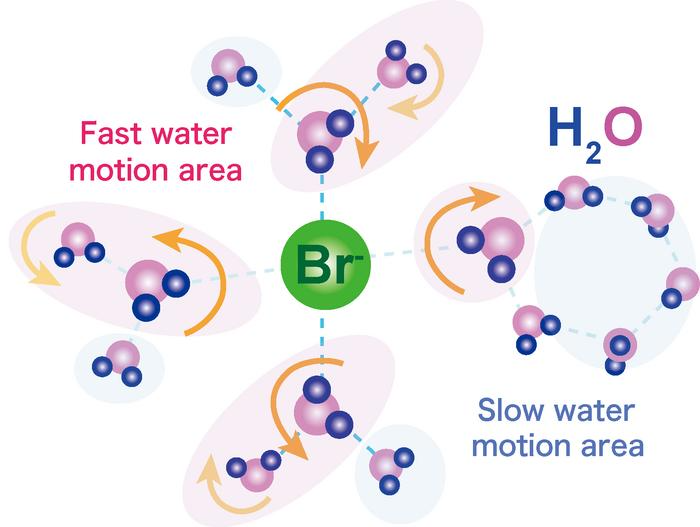The behavior of water molecules in proton-conducting materials is critical for understanding and exploiting their features. This entails being able to take very quick shots to detect changes in water motion. Osaka University researchers used quasi-elastic neutron scattering (QENS) to examine semiclathrate hydrate crystals. Their findings were reported in the journal Applied Physics Letters.
 Schematic illustration of the fast dynamics of water molecules around bromide anions (measured by QENS) and slow dynamics of the other water molecules (by NMR) in tetra-n-butylammonium bromide semiclathrate hydrate. Image Credit: 2023, Shimada et al., Quasi-elastic neutron scattering studies on fast dynamics of water molecules in tetra-n-butylammonium bromide semiclathrate hydrate, Applied Physics Letters
Schematic illustration of the fast dynamics of water molecules around bromide anions (measured by QENS) and slow dynamics of the other water molecules (by NMR) in tetra-n-butylammonium bromide semiclathrate hydrate. Image Credit: 2023, Shimada et al., Quasi-elastic neutron scattering studies on fast dynamics of water molecules in tetra-n-butylammonium bromide semiclathrate hydrate, Applied Physics Letters
Water molecule frameworks in semiclathrate hydrates accommodate other molecules or ions as ‘guests’ in their structures. By adding new guests, the overall qualities of the framework can be managed and adapted to specific requirements.
Even so, some of the finest proton conductors are extremely acidic and challenging to manage. Alternatives to solid electrolytes are consequently required. The mechanism behind the performance of tetra-n-butylammonium bromide (TBAB) semiclathrate hydrate is unknown, yet it is recognized to be a promising solid electrolyte.
Using QENS, the researchers closely examined the water molecule dynamics in TBAB semiclathrate hydrate. This gave a more precise picture of what was going on by enabling the movements of the water molecules to be caught across considerably shorter periods than had been possible with other approaches.
The transfer of protons in the semiclathrate hydrate is suspended by the water molecules. The way the water molecules then reorient—their reorientation motion—then tells us about what might be affecting the conduction.
Jin Shimada, Study Lead Author and PhD Student, Osaka University
According to QENS, water molecules in the crystal reorient themselves far more quickly than has previously been observed. The energy required to cause the shift is also comparable with the energy required to rupture a hydrogen bond, which is the type of interaction that takes place when the guest ions connect with the water molecules.
The massive bromide ion in TBAB is believed to activate the water, causing it to behave similarly to bromide in aqueous solution.
The insight we have gained into TBAB semiclathrate hydrate provides an excellent grounding for future innovation. We believe the findings will contribute to the development of batteries and thermal storage materials.
Takeshi Sugahara, Study Senior Author and Former Assistant Professor, Osaka University
Journal Reference:
Shimada, J., et al. (2023) Quasi-elastic neutron scattering studies on fast dynamics of water molecules in tetra-n-butylammonium bromide semiclathrate hydrate. Applied Physics Letters. doi:10.1063/5.0157560.